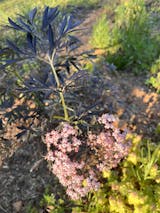
Black Lace Elderberry
Click here for Elderberry Care Guide
Sambucus nigra (European Elderberry)
- Description: Features dark purple-black leaves and pink flower clusters, maintaining its rich color throughout the growing season. It's highly ornamental and resistant to leaf diseases. This variety of elderberry fruits best when paired with another European cultivar, such as Cut Leaf.
- Height: 8 feet
- Spread: 6 to 8 feet in diameter
- Hardiness Zone: 4-9
- Pest Resistance: Very Good
- Disease Resistance: Very Good
- Drought Tolerance: Good
- Heat Tolerance: Good
- Humidity Tolerance: Good
- Sun Tolerance: Good
- Wet Soil Tolerance: Fair
- Shade Tolerance: Good
- No Spray Needed: Very Good
- Salt Tolerance: Good
- Fresh for Kids: Poor
- Deer Resistance: Fair
- Thorns: None
- Plant Type: Shrub
- Soil Type: Adaptable
- Edible Type: Berry
- Self-Fertile: No



